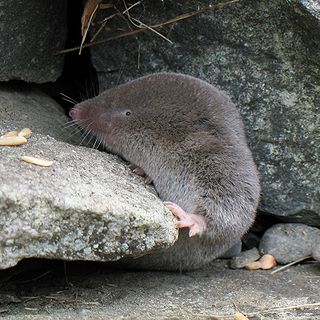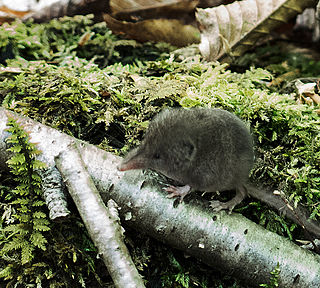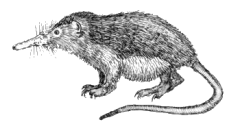Related Research Articles

Shrews are small mole-like mammals classified in the order Eulipotyphla. True shrews are not to be confused with treeshrews, otter shrews, elephant shrews, or the West Indies shrews, which belong to different families or orders.
Transient receptor potential channels are a group of ion channels located mostly on the plasma membrane of numerous animal cell types. Most of these are grouped into two broad groups: Group 1 includes TRPC, TRPV, TRPVL, TRPM, TRPS, TRPN, and TRPA. Group 2 consists of TRPP and TRPML. Other less-well categorized TRP channels exist, including yeast channels and a number of Group 1 and Group 2 channels present in non-animals. Many of these channels mediate a variety of sensations such as pain, temperature, different kinds of tastes, pressure, and vision. In the body, some TRP channels are thought to behave like microscopic thermometers and used in animals to sense hot or cold. Some TRP channels are activated by molecules found in spices like garlic (allicin), chili pepper (capsaicin), wasabi ; others are activated by menthol, camphor, peppermint, and cooling agents; yet others are activated by molecules found in cannabis or stevia. Some act as sensors of osmotic pressure, volume, stretch, and vibration. Most of the channels are activated or inhibited by signaling lipids and contribute to a family of lipid-gated ion channels.

The red-toothed shrews of the subfamily Soricinae are one of three living subfamilies of shrews, along with Crocidurinae and Myosoricinae. In addition, the family contains the extinct subfamilies Limnoecinae, Crocidosoricinae, Allosoricinae and Heterosoricinae. These species are typically found in North America, northern South America, Europe and northern Asia. The enamel of the tips of their teeth is reddish due to iron pigment. The iron deposits serve to harden the enamel and are concentrated in those parts of the teeth most subject to wear.

The northern short-tailed shrew is the largest shrew in the genus Blarina, and occurs in the northeastern region of North America. It is a semifossorial, highly active, and voracious insectivore and is present in a variety of habitats like broadleaved and pine forests among shrubs and hedges as well as grassy river banks. It is notable in that it is one of the few venomous mammals. The specific epithet, brevicauda, is a combination of the Latin brevis and cauda, meaning "short tail".

The North American least shrew is one of the smallest mammals, growing to be only up to 3 inches long. It has a long pointed snout and a tail never more than twice the length of its hind foot. The dense fur coat is either grayish-brown or reddish-brown with a white belly. Its fur becomes lighter in the summer and darker in the winter. Although similar in appearance to several species of rodents, all shrews are members of the order Eulipotyphla and should not be mistaken for a member of the order Rodentia. The North American least shrew's eyes are small and its ears are completely concealed within its short fur, giving it very poor eyesight and hearing.

The southern short-tailed shrew is a gray, short-tailed shrew that inhabits the eastern United States.

The genus Blarina is a group of relatively large shrews with relatively short tails found in North America. They have 32 teeth and are in the red-toothed shrew subfamily.
Envenomation is the process by which venom is injected by the bite or sting of a venomous animal.

The Eurasian water shrew, known in the United Kingdom as the water shrew, is a relatively large shrew, up to 10 cm (4 in) long, with a tail up to three-quarters as long again. It has short, dark fur, often with a few white tufts, a white belly, and a few stiff hairs around the feet and tail. It lives close to fresh water, hunting aquatic prey in the water and nearby. Its fur traps bubbles of air in the water which greatly aids its buoyancy, but requires it to anchor itself to remain underwater for more than the briefest of dives.

Elliot's short-tailed shrew is a small, slate grey, short-tailed species of shrew. Its common name comes from Daniel Giraud Elliot, who first described the species in 1899.

Venomous mammals are animals of the class Mammalia that produce venom, which they use to kill or disable prey, to defend themselves from predators or conspecifics or in agonistic encounters. Venomous mammals are now rare. Mammalian venoms form a heterogeneous group with different compositions and modes of action, from three orders of mammals, Eulipotyphla, Monotremata, and Chiroptera. It has been proposed that some members of a fourth order, Primates, are venomous. To explain the rarity of venom delivery in Mammalia, Mark Dufton of the University of Strathclyde has suggested that modern mammalian predators do not need venom because they are able to kill quickly with their teeth or claws, whereas venom, no matter how sophisticated, requires time to disable prey.

TRPV6 is a membrane calcium (Ca2+) channel protein which is particularly involved in the first step in Ca2+absorption in the intestine.
Kallikreins are a subgroup of serine proteases, enzymes capable of cleaving peptide bonds in proteins. In humans, plasma kallikrein (KLKB1) has no known paralogue, while tissue kallikrein-related peptidases (KLKs) encode a family of fifteen closely related serine proteases. These genes are localised to chromosome 19q13, forming the largest contiguous cluster of proteases within the human genome. Kallikreins are responsible for the coordination of various physiological functions including blood pressure, semen liquefaction and skin desquamation.

The transient receptor potential cation channel subfamily V member 1 (TrpV1), also known as the capsaicin receptor and the vanilloid receptor 1, is a protein that, in humans, is encoded by the TRPV1 gene. It was the first isolated member of the transient receptor potential vanilloid receptor proteins that in turn are a sub-family of the transient receptor potential protein group. This protein is a member of the TRPV group of transient receptor potential family of ion channels.

TRPV is a family of transient receptor potential cation channels in animals. All TRPVs are highly calcium selective.

Transient receptor potential cation channel subfamily V member 2 is a protein that in humans is encoded by the TRPV2 gene. TRPV2 is a nonspecific cation channel that is a part of the TRP channel family. This channel allows the cell to communicate with its extracellular environment through the transfer of ions, and responds to noxious temperatures greater than 52 °C. It has a structure similar to that of potassium channels, and has similar functions throughout multiple species; recent research has also shown multiple interactions in the human body.
Ctenophthalmus pseudagyrtes is a species of fleas in the family Hystrichopsyllidae. It is widespread in North America, east of the Rocky Mountains, and is found mainly on small mammals. In Missouri, it has been recorded on the Virginia opossum, northern short-tailed shrew, eastern mole, raccoon, eastern chipmunk, Florida woodrat, prairie vole, woodland vole, white-footed mouse, including nests, marsh rice rat, hispid cotton rat, house mouse, and brown rat. Hosts recorded in Tennessee include the Virginia opossum, northern short-tailed shrew, eastern mole, eastern chipmunk, southern red-backed vole, rock vole, woodland vole, white-footed mouse, golden mouse, hispid cotton rat, marsh rice rat, and house mouse.
Epitedia wenmanni is a species of flea in the family Hystrichopsyllidae. It is common throughout North America and associated mainly with Peromyscus (deermice), although many other hosts have been recorded. In Missouri, it has been found on the cat, white-footed mouse, including nests, marsh rice rat, and western harvest mouse. Hosts recorded in Tennessee include the northern short-tailed shrew, eastern chipmunk, southern red-backed vole, white-footed mouse, and golden mouse.

Brevinema andersonii, named for John F. Anderson, who first described the organism. This organism is a Gram-negative, microaerophilic, helical shaped, chemoorganotrophic organism from the genus Brevinema. Brevinema andersonii is host associated, strains have been isolated from blood and other tissues of short-tailed shrews and white-footed mice and are infectious for laboratory mice and Syrian hamsters.B. andersonii is readily identified by restriction enzyme analysis, and SDS-PAGE, or fatty acid composition data. Another identifier for B. andersonii is the sheathed periplasmic flagella in the 1-2-1 configuration. While cells are visible by dark-field or phase-contrast microscopy, they cannot be seen when bright-field microscopy is used.
References
- 1 2 Soricidin - Blarina brevicauda (Northern short-tailed shrew) at UniProt; version 15; published October 31, 2012; retrieved December 13, 2013
- ↑ Venom of the Short-Tailed Shrew (Blarina brevicauda) as an Insect Immobilizing Agent, by Irwin G. Martin, in the Journal of Mammalogy (archived at JSTOR); Vol. 62, No. 1 (Feb., 1981), pp. 189-192
- 1 2 The Stunning Saliva Of Shrews: Researchers are trying to unravel the mystery of the shrew's venomous brew, by Rachel Sheremeta Pepling; in Chemical & Engineering News ; published October 13, 2004; retrieved December 13, 2013
- ↑ Shrew spit tames cancer cells at CBC.ca; published May 24, 2010; retrieved December 13, 2013
- ↑ In Vivo Detection of Human TRPV6-Rich Tumors with Anti-Cancer Peptides Derived from Soricidin, by Chris V. Bowen, Drew DeBay, H. Stephen Ewart, Pamela Gallant, Sean Gormley, T. Toney Ilenchuk, Umar Iqbal, Tyler Lutes, Marzia Martina, Geoffrey Mealing, Nadine Merkley, Sandra Sperker, Maria J. Moreno, Christopher Rice, Raymond T. Syvitski, and John M. Stewart; in PLoS One ; published: March 15, 2013; retrieved December 13, 2013; DOI: 10.1371/journal.pone.0058866
- ↑ The Seventh Annual Ion Channel Retreat - Vancouver, Canada, June 29 – July 1, 2009 - MEETING REPORT, by Saranna Brugger, Susannah Kennedy, and Noel King; in ASSAY and Drug Development Technologies; vol. 8, no. 1, February 2010; doi: 0.1089/adt.2009.0241
- ↑ Quest for a wonder drug started with shrew bait, by Dakshana Bascaramurty; at The Globe and Mail ; published August 8, 2012; retrieved December 13, 2013
- ↑ Open up and say 'aah', by Tom Henheffer; at Maclean's ; published July 1, 2010; retrieved December 13, 2013